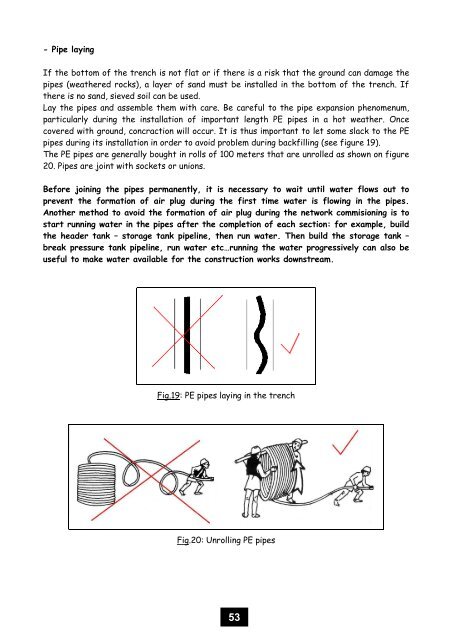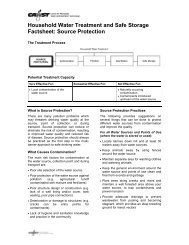Module 4 - Construction of a gravity fed system
Module 4 - Construction of a gravity fed system
Module 4 - Construction of a gravity fed system
Create successful ePaper yourself
Turn your PDF publications into a flip-book with our unique Google optimized e-Paper software.
- Pipe laying<br />
If the bottom <strong>of</strong> the trench is not flat or if there is a risk that the ground can damage the<br />
pipes (weathered rocks), a layer <strong>of</strong> sand must be installed in the bottom <strong>of</strong> the trench. If<br />
there is no sand, sieved soil can be used.<br />
Lay the pipes and assemble them with care. Be careful to the pipe expansion phenomenum,<br />
particularly during the installation <strong>of</strong> important length PE pipes in a hot weather. Once<br />
covered with ground, concraction will occur. It is thus important to let some slack to the PE<br />
pipes during its installation in order to avoid problem during backfilling (see figure 19).<br />
The PE pipes are generally bought in rolls <strong>of</strong> 100 meters that are unrolled as shown on figure<br />
20. Pipes are joint with sockets or unions.<br />
Before joining the pipes permanently, it is necessary to wait until water flows out to<br />
prevent the formation <strong>of</strong> air plug during the first time water is flowing in the pipes.<br />
Another method to avoid the formation <strong>of</strong> air plug during the network commisioning is to<br />
start running water in the pipes after the completion <strong>of</strong> each section: for example, build<br />
the header tank – storage tank pipeline, then run water. Then build the storage tank –<br />
break pressure tank pipeline, run water etc…running the water progressively can also be<br />
useful to make water available for the construction works downstream.<br />
Fig.19: PE pipes laying in the trench<br />
Fig.20: Unrolling PE pipes<br />
53

















